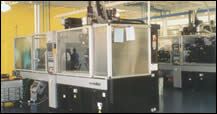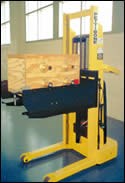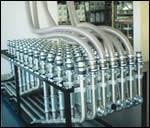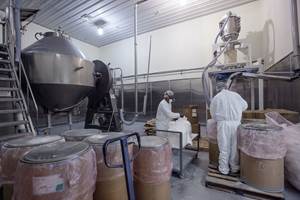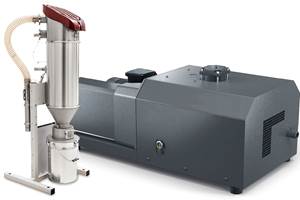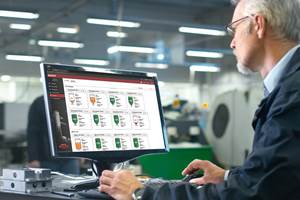Small Molder Builds a High-Tech Showplace
How does a small injection molding company position itself to compete with much larger, technically sophisticated rivals?
How does a small injection molding company position itself to compete with much larger, technically sophisticated rivals? The answer is to find powerful allies to give you a hand. That philosophy has guided John Winzeler throughout a 20-year project to transform his tiny company, Winzeler Gear, into a showplace of advanced manufacturing.
Starting in the mid-’80s, Winzeler began remaking the Chicago-based metal-stamping company (then called Winzeler Inc.) that he had inherited from his father into a business dedicated to custom injection molding of plastic gears. He formed close alliances with a number of suppliers, including Engel for injection machines and robots, DuPont for materials, and Labotek for materials-handling auxiliaries. His plant became their research lab and beta-test site to try out new products, a training site for their employees, and a showplace for their customers.
Tangible results of those partnerships are visible in a new addition to the Winzeler plant, which is being configured to employ all-electric molding presses, quick mold changing, automated process set-up, robotic parts removal and box loading, machine vision, automated parts inspection at the press, bar-code labeling, fully automated drying and materials handling, and parts take-away by automated guided vehicles (AGVs).
The new Winzeler
Winzeler’s original plant floor of 20,000 sq ft barely has room for 24 Engel hydraulic presses of 30 to 200 tons. Last year, he doubled the floor space by purchasing the building next door and joining it to his old plant. The new wing has room for 20 more machines.
Winzeler Gear employs 35 and can produce 15 million gears a month. It does more than $9 million in annual business, almost all of it automotive. The company is believed to be the only one in North America that molds nothing but gears.
Automating Q-C
“Today, our largest department is quality,” says Winzeler. “We have automated almost all activities except quality assurance. Since all our machines run without operators, we have roving inspectors that gather samples every two to three hours and bring them to the quality lab.”
Reducing labor costs for inspection—as well as packaging and material handling—was a key concern in designing the new wing: “Our original building runs 24 machines with five persons per shift. Our goal for the new building is to run 20 presses with two people per shift,” Winzeler explains.
Right now, the new space houses two automation cells based on 110-ton Engel all-electric machines. A third cell will be installed in June. Winzeler is conducting tests to verify machine builders’ claims that electric presses are more accurate than hydraulics. Winzeler likes the electric machines because they are quiet and have very low cooling-water requirements.
The two new machines are among the first in North America with Engel’s newest quick-mold-change (QMC) system. It is assisted by a mold cart custom designed for Winzeler Gear by a Milwaukee firm. The cart has rails that allow molds to slide on rollers mounted on four pins projecting from the mold.
A mold can be rolled onto the cart from a rack placed against one wall of the new wing. The cart is rolled up to the press, and the mold is rolled into the clamp area until it hits a stop. Then four tapered locking pins engage holes in the projecting pins. Quick-change water fittings and hot-runner heater connections enable complete mold changes in 20 to 25 min.
Each electric machine cell has machine-vision cameras to watch for accidents that could damage the mold or robot. Each also has an Engel servo robot that demolds parts and packs them in trays. Boxes are now packed with an exact part count instead of simply by weight. The new cells also pack parts from each cavity in a separate box. With this new cavity-separation procedure, if one cavity goes bad, Winzeler can maintain delivery of good parts without the hassle of sorting out the rejects.
Because gear dimensions are sensitive to slight variations in cavity filling, the goal is 100% part inspection at the press. The robot places a gear in a prototype test device that turns the gear against a master gear and checks the fit. Notes quality director Mark Smith, “We still have to validate that measuring gears while warm will match test results in a cooled state.”
Winzeler’s scrap rate is already less than 0.5%, but he would like to push it even lower. “We are trying to understand and optimize our processes,” explains Harry Soling, director of manufacturing. They’re using portable eDART process monitors from RJG Inc. to study 20 process parameters to determine which are useful for automatic QC. A total of 150 process parameters, plus production data, are monitored by the central EngelNet PC that is connected to all machines in the plant. EngelNet is also used to download set-up parameters to each machine.
“The last two customer rejects we had were because the wrong shipping label got on the box,” says Smith. To prevent any recurrences, Winzeler installed bar-code scanners on 12 machines last year. The scanner reads the preprinted label on the box and sends data on the part number, quantity, customer, lot number, date, and time produced to the plant’s ERP system. The filled box is manually transferred to a conveyor where another scanner rereads the bar code and a labeler prints out the information and applies the label to the box. Winzeler plans to install wire-guided AGVs to transport boxes from the press to the labeler.
Automated resin conveying
The new wing created the opportunity to centralize materials handling and water chilling. Housed in the annex is a Labotek twin-bed desiccant dryer and a bank of six drying hoppers, soon to be expanded to 12, which supply the two new presses and eight more in the old wing. Temperature of each hopper is independently controlled. Labotek also supplied the conveying system, whose manifold can distribute up to 20 materials via an overhead cluster of aluminum conveying tubes with ceramic-coated bends to resist wear from glass-filled materials.
Process engineer Warren Edmondson enthuses over the new system: “Before, we had a dryer and blower on each machine. Now four blowers can serve the whole plant. That means big energy savings.” The system also greatly reduces the workload of the material handler. Edmondson admires the system’s automatic line-clearing function, which speeds material changeovers by blowing the lines clean. “We just wipe out the hopper and clean the filter.”
The brains of the drying and conveying system is a wall-mounted color touchscreen controller—the first of Labotek’s new-generation systems to be installed in North America. It checks the electronic addresses of each drying hopper and vacuum receiver to make sure material goes to the right destination.
When the new wing was opened, Winzeler Gear replaced the cooling tower with a central closed-loop chilling system that serves the entire plant. “The central chiller requires a lot less maintenance than the cooling tower, which we had to shut down twice a year,” says Edmondson. “And there’s no scale deposits in the lines because of the closed-loop system.”
Related Content
Conveyor Controller Ideal for Expanding Plants
Billed as the most flexible and reliable discrete wired conveying controller on the market.
Read MoreCut Loading Time Through Direct Charge Blending
Direct charge blender loading, a vacuum-powered automation process, can dramatically improve loading time and reduce material costs. In this article, we address ten common questions to help you determine if the systems are right for your facility.
Read MoreCentral Controller, Energy-Efficient Pump for Conveying
Wittmann debuts new control system and pump at Fakuma.
Read MoreSingle View of Bin & Silo Material Levels in Multiple Locations
Got a bin in Buffalo and a silo in San José? BinMaster’s latest addition to its cloud inventory software lets you see all your resin inventory anywhere in one view.
Read MoreRead Next
Troubleshooting Screw and Barrel Wear in Extrusion
Extruder screws and barrels will wear over time. If you are seeing a reduction in specific rate and higher discharge temperatures, wear is the likely culprit.
Read MoreAdvanced Recycling: Beyond Pyrolysis
Consumer-product brand owners increasingly see advanced chemical recycling as a necessary complement to mechanical recycling if they are to meet ambitious goals for a circular economy in the next decade. Dozens of technology providers are developing new technologies to overcome the limitations of existing pyrolysis methods and to commercialize various alternative approaches to chemical recycling of plastics.
Read More


